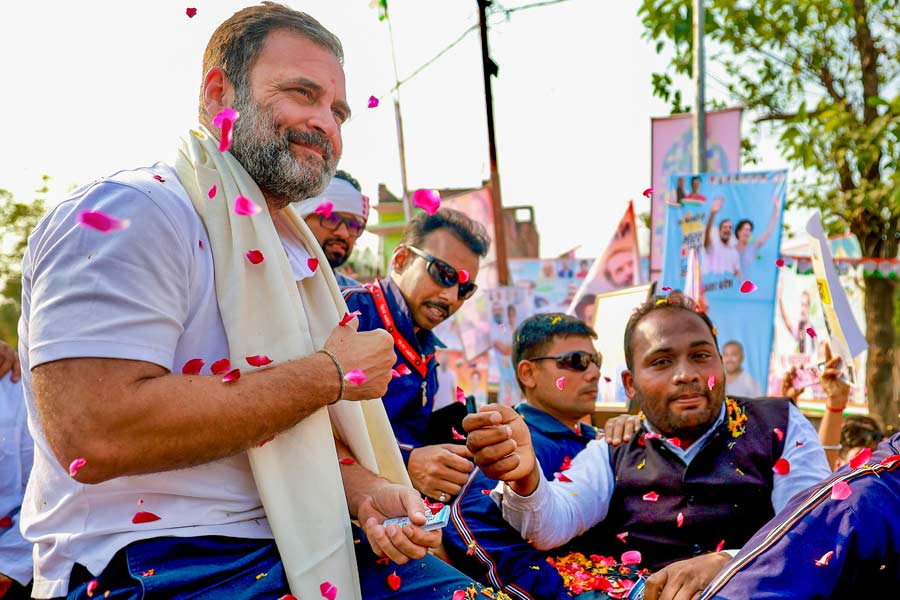Rahul Gandhi, who had framed his electoral discourse around corruption in the 2019 parliamentary election by drawing attention to the Rafale deal, has broadened the canvas this time by weaving his narrative around injustice which allows him to cover a much wider range of issues — social, economic as well as political.
Although Rahul had inserted “Nyay” (minimum income guarantee) in his 2019 campaign in the later stages, the focus remained on Narendra Modi’s alleged corruption in the Rafale deal even as the Congress machinery refused to back either of his pet issues. This time, though the Congress hasn’t picked up the social justice campaign in a big way despite Rahul’s sustained focus on the caste census demand, the overall emphasis on injustice finds echo in the party’s communication system.
It is an undeniable truth that the majority of Congress leaders, including spokespersons, do not feel passionately about caste discrimination and haven’t started to sing along with Rahul, who never misses an opportunity to dwell on the question of caste census. However, there is no escape from this issue because the party has built its entire campaign on the theme of justice. The five pillars of the campaign are — justice for youth, women, farmers, workers and representation.
The Congress has called Modi’s 10-year rule “Anyay Kaal”, offering justice to all sections of society. This is such a broad spectrum that, unlike the narrow, unifocal stress on one issue of a defence deal, the current narrative encompasses a wide range of issues — from unemployment to prices, from farmers to OBCs, from youth to women, from the poor to the minorities. “Rahulji has created a rich-versus-all narrative,” summed up a Congress leader.
Rahul tweeted on Sunday: “Were the loans taken by Modi’s friends waived off? Yes. Was the corporate tax lowered to help Modi’s friends? Yes. Did Modi’s friends get cheap land? Yes. Did farmers’ income double? No. Did farmers get loan waiver? No. Modi has betrayed India by framing a crony policy that enabled 1% elite people to capture India’s resources. The Congress is committed to make fair policies for farmers, workers, and the poor standing at the end of the queue.”
Congress sources believe Rahul has established a strong rapport with the youth by forcefully raising issues like unemployment, paper leak, recruitment scams and flawed schemes like Agniveer. He firmly aligned with the farmers by announcing a legal guarantee for MSP (minimum support price), while several other schemes for the agriculture sector will be announced in the manifesto. By promising a basic income for everybody, the Congress is set to woo the workers and other categories of the poor in society.
The most critical element of Rahul’s strategy is social justice. While he was initially projecting 73 per cent of the population (OBC, Dalits and tribals) as the deprived sections, he has now added minorities (15 per cent), insisting that the suffering lot was 88 per cent.
The narrative attracted enthusiastic public response in Bihar, where social justice has always been a potent political weapon. Alliance partner Tejashwi Yadav has now taken out a Jan Vishwash Yatra to bolster his track record of giving lakhs of jobs in a
short span of time and the public response has so far been encouraging.
In Uttar Pradesh, Rahul became exceptionally aggressive on the question of social justice, jolting the suffering masses out of inertia and telling them that they would be finished if they didn’t fight for their rights.
While the BJP’s vote share may appear insurmountable for the Congress-SP combine as the BSP has steadfastly refused to join the alliance, Rahul’s sharp focus on caste census and justice has the potential to stir up the social cauldron.
When Rahul took out the Bharat Jodo Yatra from Kanyakumari to Kashmir,
the BJP raised questions about the purpose of such an exercise, asking what was broken that needed to be fixed. But the BJP hasn’t been able to whip up a similar propaganda about the Nyay Yatra, which specifically points to injustice being done to farmers, youth, workers and women, apart from the question of social representation and empowerment.
The welfare discourse that dominated the Congress politics till a few months ago was met by the BJP with a counter-narrative of Modi’s guarantee. But Modi’s rhetoric has so far not been able to defuse the injustice agenda.











